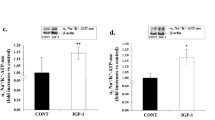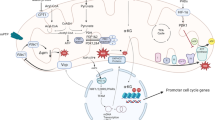Abstract
Polyunsaturated fatty acids (PUFAs) such as docosahexaenoic and eicosapentaenoic acids (DHA, EPA) exert ischemic anti-arrhythmic effects. However, their mechanism of action remains unknown. The present study was designed to investigate their potential effect on the regulation of the late sodium current as the basis for their ischemic anti-arrhythmic activity. Human isoforms of wild-type SCN5A and ΔKPQ-mutated cardiac sodium channels were stably transfected in HEK 293 cells and, the resulting currents were recorded using the patch clamp technique in whole cell configuration. In addition to their effect to inhibit peak INa, acute application of DHA and EPA blocked veratridine-induced late sodium current (late INa-Verat) in a concentration — dependent manner with IC50 values of 2.1 ± 0.5 μM and 5.2 ± 0.8 μM,for DHA and EPA, respectively.Channels availability was reduced, resulting in a significant leftward shift of the steadystate inactivation curve by ‒10.0 ± 2.1 mV and ‒8.5 ± 0.2 mV for DHA and EPA, respectively. Similar inhibitory effects of DHA and EPA were also observed on late INa-KPQ. In addition to their role as blocking agents of peak INa, DHA and EPA reduced human late INa. These results could explain the antiarrhythmic properties of DHA and EPA during ischemia or following ischemia-reperfusion.
Similar content being viewed by others
References
Antzelevitch C, Fish J (2001) Electrical heterogeneity within the ventricular wall. Basic Res Cardiol 96:517–527
Antzelevitch C, Belardinelli L, Zygmunt AC, Burashnikov A, DiDiego JM, Fish JM, Cordeiro JM, Thomas G (2004) Electrophysiological effects of ranolazine, a novel antianginal agent with antiarrhythmic properties. Circulation 110:904–910
Balser JR (2001) The cardiac sodium channel: gating function and molecular pharmacology. J Mol Cell Cardiol 33:599–613
Bennett PB, Yazawa K, Makita N, George Al Jr (1995) Molecular mechanism for an inherited cardiac arrhythmia. Nature 376:683–685
Billman GE, Kang JX, Leaf A (1997) Prevention of ischemia-induced cardiac sudden death by n-3 polyunsaturated fatty acids in dogs. Lipids 32:1161–1168
Brouwer IA, Zock PL, Camm JA, Bocker D, Hauer RNW, Wever EFD, Dullemeijer C, Ronden JE, Katan MB, Lubinski A, Buschler H, Schouten EG (2006) Effect of fish oil on ventricular tachyarrhythmia and death in patients with implantable cardioverter defibrillators. The Study on omega-3 fatty acids and ventricular arrhythmia (SOFA) randomized trials. JAMA 295:2613–2619
Burr ML, Ashfield-Watt PA, Dunstan FD, Fehily AM, Breay P, Ashton T, Zotos PC, Haboubi NA, Elwood PC (2003) Lack of benefit of dietary advice to men with angina: results from a controlled trial. Eur J Clin Nutri 57:193–200
Christensen JH, Riahi S, Schmidt EB, Molgaard H, Kirstein Pedersen A, Heath F, et al. (2005) n-3 Fatty acids and ventricular arrhythmias in patients with ischaemic heart disease and implantable cardioverter defibrillators. Europace 7:338–344
Coraboeuf E, Deroubaix E, Coulombe A (1980) Acidosis-induced abnormal repolarization and repetitive activity in isolated dog Purkinje fibers. J Physiol (Lond) 76:97–106
Den Ruijter HM, Berecki G, Opthof T, Verkerk AO, Zock PL, Coronel R (2007) Pro- and antiarrhythmic properties of a diet rich in fish oil. Cardiovasc Res 73:316–325
Dumaine R, Wang Q, Keating MT, Hartmann HA, Schwartz PJ, Brown AM, et al. (1996) Multiple mechanisms of Na+ channel-linked long-QT syndrome. Circ Res 78:916–924
Eigel BN, Hadley RW (1999) Contribution of the Na+ channel and Na+/H+ exchanger to the anoxic rise of [Na+] in ventricular myocytes. Am J Physiol Heart Circ Physiol 277:H1817–H1822
Fedida D, Orth PMR, Hesketh CJ, Ezrin AM (2006) The Role of late INa and antiarrhythmic drugs in EAD formation and termination in Purkinje fibers. J Cardiovasc Electrophysiol 17:S71–S78
Gellens M, George A, Chen L, Chahine M, Horn R, Bardin R, Kallen R (1992) Primary structure and functional expression of the human cardiac tetrodotoxin-insensitive voltage-dependent sodium channel. Proc Natl Acad Sci USA 89:554–558
Haigney MC, Lakatta EG, Stern MD, Silverman HS (1994) Sodium channel blockade reduces hypoxic sodium loading and sodium-dependent calcium loading. Circulation 90:391–399
Hammarstrom AK, Gage PW (2002) Hypoxia and persistent sodium current. Eur Biophys J 31:323–330
Heusch G (1994) Ischemia-selectivity: a new concept of cardioprotection by calcium antagonists. Basic Res Cardiol 89:2–5
Huang B, El Sherif T, Gidh-Jain M, Quin D, El sheriff N (2001) Alterations of sodium channel kinetics and gene expression in the postinfarction remodeled myocardium. J Cardiovasc Electrophysiol 12:218–225
Ju YK, Saint DA, Gage PW (1996) Hypoxia increases persistent sodium current in rat ventricular myocytes. J Physiol (Lond) 497:337–341
Ju YK, Saint DA, Gage PW (1994) Inactivation- resistant channels underlying the persistent sodium current in rat ventricular myocytes. Proc Biol Sci 256:163–168
Leaf A, Albert CM, Josephson M, Steinhaus D, Kluger J, Kang JX, Cox B, Zhang H, Schoenfeld D (2005) Prevention of fatal arrhythmias in high-risk subjects by fish oil n-3 fatty acid intake. Circulation 112:2762–2768
Leaf A, Xiao YF, Kang JX, Billman GE (2005) Membrane effects of the n-3 fish oil fatty acids, which prevent fatal ventricular arrhythmias. J Membr Biol 206:129–139
Leifert WR, McMurchie EJ, Saint DA (1999) Inhibition of cardiac sodium currents in adult rat myocytes by n-3 polyunsaturated fatty acids. J Physiol (Lond) 520:671–679
Li RA, Tomaselli GF, Marban EM (2004) Sodium channels. In: Zipes DP, Jalife J (eds) Cardiac Electrophysiology: From Cell to Bedside. Philadelphia, PA, Saunders, pp 1–9
Liu Y-M, De Felice LJ, Mazzanti M (1992) Na channels that remain open throughout the cardiac action potential plateau. Biophys J 63:654–662
Makielski JC, Farley AL (2006) Na+ current in human ventricle: Implications for sodium loading and homeostasis. J Cardiovasc Electrophysiol 17:S15–S20
Maltsev VA, Sabbah HN, Higgins RS, Silverman N, Lesch M, Undrovinas AI (1998) Novel, ultraslow inactivating sodium current in human ventricular cardiomyocytes. Circulation 98:2545–2552
Marchioli R, Barzi F, Bomba E, Chieffo C, Di Gregorio D, Di Mascio R et al. GISSIPrevenzione Investigators (2002) Early protection against sudden death by n-3 polyunsaturated fatty acids after myocardial infarction: time-course analysis of the results of the Gruppo Italiano per lo Studio della Sopravvivenza nell’Infarto Miocardico (GISSI)-Prevenzione. Circulation 105:1897–1903
Raitt MH, Connor WE, Morris C,Kron J, Halperin B, Chugh SS, McClelland J, Cook J, MacMurdy K, Swenson R, Connor SL, Gerhard G, Kraemer DF, Oseran D, Marchant C, Calhoun D, Shnider R, McAnulty J (2005) Fish oil supplementation and risk of ventricular tachycardia and ventricular fibrillation in patients with implantable defibrillators.A rondomized controlled trial. JAMA 293:2884–2891
Saint DA, Ju YK, Gage PW (1992) A persistent sodium current in rat ventricular myocytes. J Physiol 453:219–231
Saint DA (2006) The role of the persistent Na+ current during cardiac ischemia and hypoxia. J Cardiovasc Electrophysiol 17:S96–S103
Sakmann BF, Spindler AJ, Bryant SM, Linz KW, Noble D (2000) Distribution of a persistent sodium current across the ventricular wall in guinea pigs. Circ Res 87:910–914
Song Y, Shryock JC, Wu L, Belardinelli L (2004) Antagonism by ranolazine of the pro-arrhythmic effects of increasing late INa in guinea pig ventricular myocytes. J Cardiovasc Pharmacol 44:192–199
Sunami A, Sasano T, Matsunaga A, Fan Z, Swanobori T, Hiraoka M (1993) Properties of veratridine-modified single Na+ channels in guinea pig ventricular myocytes. Am J Physiol Heart Circ Physiol 264:H454–H463
Tamareille S, Le Grand B, John GW, Feuvray D, Coulombe A (2002) Antiischemic compound KC 12291 prevents diastolic contracture in isolated atria by blockade of voltage-gated sodium channels. J Cardiovasc Pharmacol 40:346–355
Undrovinas AI, Fleidervish IA, Makielski JC (1992) Inward sodium current at resting potentials in single cardiac myocytes induced by the ischemic metabolite lysophosphatidylcholine. Circ Res 71:1231–1241
Undrovinas AI, Maltsev VA, Sabbath HN (1999) Repolarization abnormalities in cardiomyocytes of dogs with chronic heart failure: Role of sustained inward current. Cell Mol Life Sci 55:494–505
Valdivia CR, Chu WW, Pu J, Foell JD, Haworth RA, Wolff MR, Kamp TJ, Makielski JC (2005) Increased late sodium current in myocytes from a canine heart failure model and from failing human heart. J Mol Cell Cardiol 38:475–483
Verdonck F (1995) How high does intracellular sodium rise during acute myocardial ischaemia? Cardiovasc Res 29:278
Verkerk AO, Van Ginneken ACG, Berecki G, Den Ruijter HM, Schumacher CA, Veldkamp MW, et al. (2006) Incorporated sarcolemmal fish oil fatty acids shorten pig ventricular action potentials. Cardiovasc Res 70:509–520
Wang DW, Yazawa K, George AL Jr, Bennett PB (1996) Characterization of human cardiac Na+ channel mutations in the congenital long QT syndrome. Proc Natl Acad Sci USA 93:13200–13205
Wu L, Shryock JC, Song Y, Li Y, Antzelevitch C, Belardinelli L (2004) Antiarrhythmic effects of ranolazine in a guinea pig in vitro model of Long QT syndrome. J Pharmacol Exp Ther 310:599–605
Xiao YF, Ke Q, Wang SY, Auktor K, Yang Y, Wang GK, et al. (2001) Single point mutations affect fatty acid block of human myocardial sodium channel α- subunit Na+ channels. Proc Natl Acad Sci USA 98:3606–3611
Xiao Y-F, Ma L, Wang S-Y, Josephson ME, Wang GK, Morgan JP, Leaf A (2006) Potent block of inactivation-deficient Na+ channels by n-3 polyunsaturated fatty acids. Am J Physiol Cell Physiol 290:C362–C370
Xiao YF, Sigg DC, Leaf A (2005) The antiarrhythmic effect of n-3 polyunsaturated fatty acids: modulation of cardiac ion channels as a potential mechanism. J Memb Biol 206:141–154
Xiao YF, Wright SN, Wang GK, Morgan JP, Leaf A (1998) Fatty acids suppress voltage-gated Na+ currents in HEK293t cells transfected with the α-subunit of the human cardiac Na+ channel. Proc Natl Acad Sci USA 95:2680–2685
Xiao YF,Wright SN,Wang GK, Morgan JP, Leaf A (2000) Coexpression with β1- subunit modifies the kinetics and fatty acid block of hH1α Na+ channels. Am J Physiol Heart Circ Physiol 279:H35–H46
Author information
Authors and Affiliations
Corresponding author
Rights and permissions
About this article
Cite this article
Pignier, C., Revenaz, C., Rauly-Lestienne, I. et al. Direct protective effects of poly-unsaturated fatty acids, DHA and EPA, against activation of cardiac late sodium current. Basic Res Cardiol 102, 553–564 (2007). https://doi.org/10.1007/s00395-007-0676-x
Received:
Revised:
Accepted:
Published:
Issue Date:
DOI: https://doi.org/10.1007/s00395-007-0676-x




